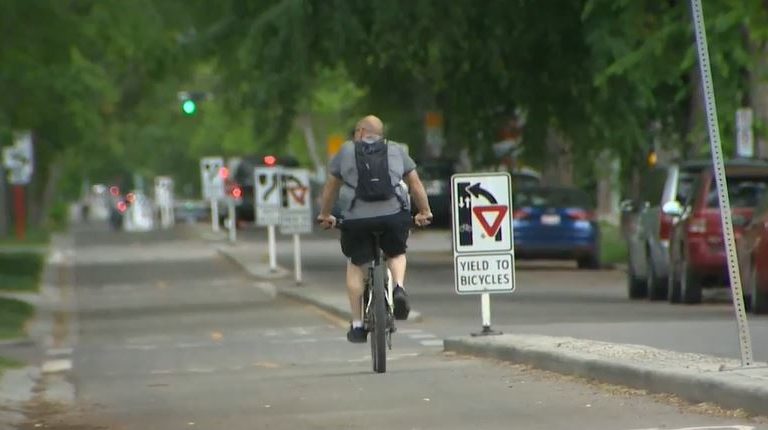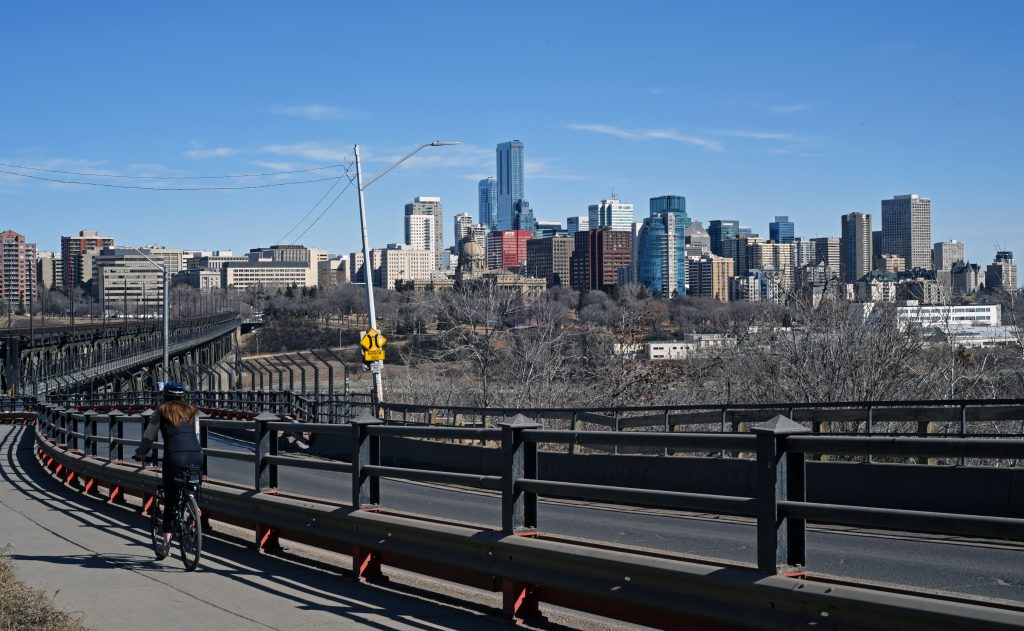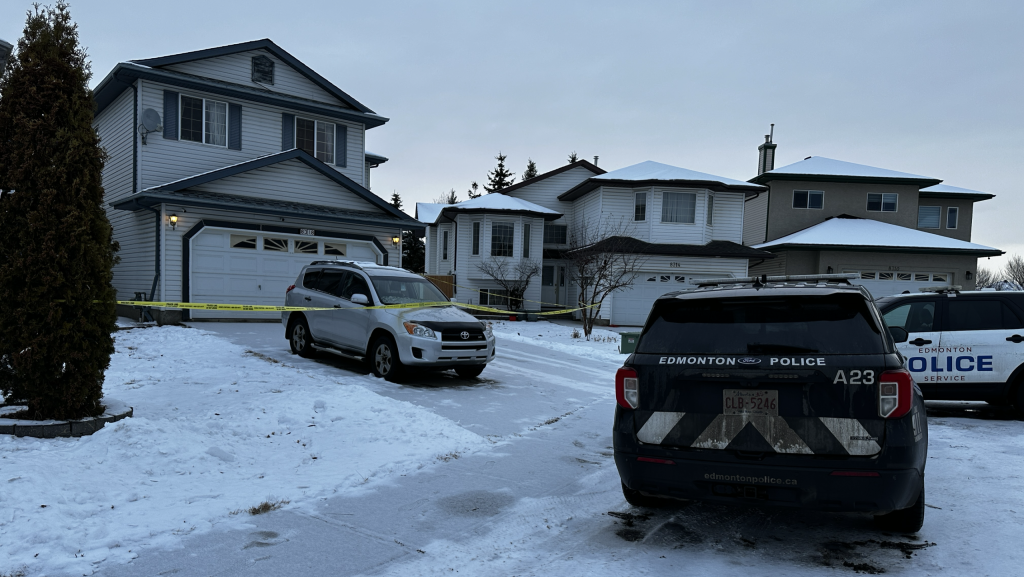Edmonton touted as cycling model for North American cities

Posted October 15, 2023 5:53 pm.
Last Updated October 15, 2023 9:29 pm.
If you build it, they will come.
That’s how avid urban cyclist and Calgary content creator Tom Babin feels about bike lanes – build them, and they can turn car-dominated, traffic-heavy cities into cycling havens.
And that might very well be the plan for Edmonton.
“What we see in cities all over the world is that when cycling is made safe and convenient, then people will ride their bikes,” Babin told CityNews. “And what works in other places is a feeling of safety. And so separation from motor vehicles is really important.
“There’s a hardcore group of cyclists who will ride no matter what, but if we want regular people who don’t consider themselves cyclists or we’re just looking for a different way of getting around, and we want them to ride their bikes, it needs to be made safe. And we see this over and over again: when safe bike lanes are implemented, people will use them.”
Babin’s gaze is fixed squarely on Alberta’s capital. He called Edmonton “the most exciting bike city in North America” in a nearly 18-minute video posted to his YouTube channel “Shifter” last week, where he documents his life as an urban cyclist to his nearly 100,000 subscribers.
The video puts a spotlight on Edmonton’s “ambitious urban cycling plan.” In December, city council approved a $100 million bike plan over four years; it was that announcement that caught Babin’s eye in the first place.
“I absolutely think if a city like Edmonton wants to encourage more people to cycle you need to invest in it,” said Babin. “You need to make it safer for people. And so I think that’s a huge opportunity that’s happening here. And it’ll be really interesting to see how this money is spent and how it really can change the city.”
Babin made his way up to Edmonton from Calgary after receiving an invitation from city councillor Michael Janz. In the video – which has been seen more than 32,000 times in five days – Babin tests out the city’s bike lanes and trails. He also speaks to Coun. Janz, Coun. Ashley Salvador, business owners, bike advocates and a city engineer.
“I spent a couple of days riding around, looking at what exists now,” he said. “What (changes) do we think there’s going to be, and just sort of got to check on the city because it’s an exciting moment.”

A major takeaway for Babin about Edmonton: the city is community-driven and filled with people who care enough about cycling to advocate for bike infrastructure in a big way.
“People in the business community, people from the development community, politicians, administrators, and just people who like bikes, and people who maybe don’t even bike but understand the benefits of cycling, all seem to have come together and got prepared for it and then when the moment arrived, they were able to advocate for this investment.”
Active transportation connects city: advocate
Stephen Raitz, a board member with Edmonton-based accessible transportation advocacy group “Paths for People,” was featured in Babin’s video. The two connected through Coun. Janz.
Raitz says the video “puts Edmonton on the map” by showcasing the capital’s plan to expand bike infrastructure.
One of the by-products of cycling and active transportation in general, according to him, is that residents of a city can interact with each other.
“Getting around actively, whether you’re walking, rolling or biking, is a great way to connect with your community,” he said. “It’s so much easier when you’re getting around actively to say hi to a neighbour, to stop and connect with somebody on the street… Active transportation can be such a community connector if we make it easier and a more convenient choice.
“We built so much of our city focused on just moving around cars as fast as possible. We want to have a city where we have safer, more livable streets, where there are modes of transportation that are actually options for people that are convenient and safe, like biking or walking or getting around on transit.”
A video portraying Edmonton as a city with such a bike-friendly future was no surprise to cycling enthusiast Kelly Hodgson, the general manager at United Sport & Cycle.
He says safety is paramount when it comes to bike lanes, having himself changed his cycling route for that very reason.

“I was coming through Sherwood Park and then coming on the freeway and coming in on Whyte Ave and you’re dealing with motorists and especially at this time of year, you’re talking about late sunrise and early dusk and so I’ve got lights, I’ve got reflective clothing, I’m doing my best to be seen, but at the end of the day I’m not as big as a car.
“So being able to go through a trail system and then through bike lanes to be able to get here is certainly a lot more comfortable.”
Hodgson points to the River Valley system, which spans 160 kilometres, as a favourite among cyclists. He says the trails need to be safe and accessible and must be maintained for years to come.
Cost of cycling infrastructure
In Babin’s video, Coun. Salvador suggests the cost of cycling infrastructure is less than what’s spent on one overpass, saying bike lanes cost property owners 33 cents in taxes.
“I think people seem to lose sense of proportion,” Babin told CityNews. “We seem to have very little debate when we spend $200 million or $300 million, or even a billion dollars on a road project. But we seem to get up in arms over any kind of investment in cycling. But really, it’s a fraction of the budget. It’s really a drop in the bucket when you look at the bigger picture of transportation in Edmonton, especially when you spread it over a number of years.
“Cities have done it and even cities in Canada, we look at Montreal that’s had a consistent investment in good cycling infrastructure for more than 20 years now. It makes a huge difference and it makes people’s lives better, safer and healthier.”
Raitz was hardly surprised by the financial figures shared by Salvador, saying bike infrastructure cost is “minimal… in the grand scheme of things.”
“We’re just excited that that kind of message is getting out there now because it can really help rationalize why we want to make this change for more Edmontonians,” said Raitz. “More people can buy into the idea of the relative low cost of this infrastructure.
“And I think it can build more political will and longer term of really being better stewards of taxpayer dollars and ensuring that we’re not necessarily expanding highways forever and ever because we see that as a waste of money. And so I think the tide is beginning to turn too because numbers like that are getting out there more and more.
“And I don’t think we’ll get everybody on the same page, but I think you’ll get more and more Edmontonians and more North Americans understanding that our current style of development is not financially feasible in the long term. So it’s time to start making different decisions and difficult decisions as well.”

As his gaze shifted to Edmonton, Babin feels other cities will also begin looking to Alberta’s capital city “with envy.”
“I think they’re looking at a city like Edmonton making this kind of an investment as a leader in this space,” said Babin. “And I think what happens in the city over the next few years could have influence in a lot of other places.
“I hope Edmontonians understand they’re in a unique position here. And they could have influence in a bigger way than they might understand. I think it’s a real opportunity for the city.”








